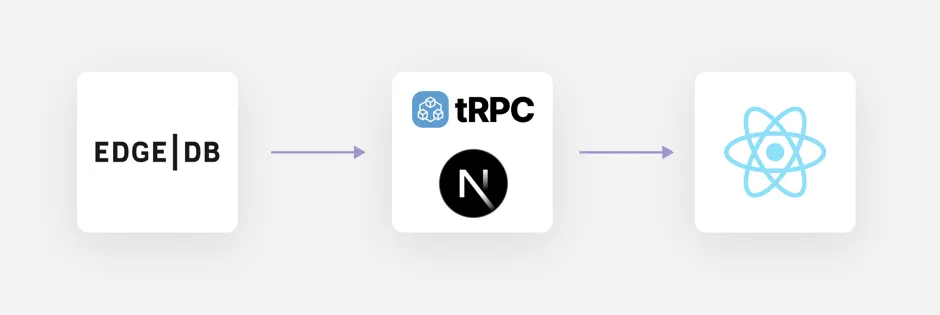I’m Jack, the founder of Credal.ai, where we make heavy use of EdgeDB to iterate faster on our product. Credal helps organizations including unicorn startups and publicly traded companies use their internal data with AI to reap the productivity benefits that AI promises while protecting sensitive information. We take care of things like mirroring permissions from data source systems, audit logging, and private data redaction to give IT and security teams what they need, while letting users integrate data and retrieval-augmented generation (RAG) to create copilots and tools that can accelerate their entire organization.
Why EdgeDB?
When I built applications in the past, I remained floored by the amount of boilerplate and wiring involved even in simple apps, the unworkability of ORMs, and how much attention was drawn away from the purpose of whatever you’re building and towards simply making tools cooperate. Persistence appeared to be a particularly bad offender: interacting with databases remains surprisingly error prone and time consuming, and tools like ORMs often seem to make it worse and not better.
When I saw EdgeDB on Hacker News in 2019, I finally knew I wasn’t crazy, and that this was by far the most promising option I had come across.
We’re building in enterprise AI which is one of the fastest moving and most competitive areas in software right now. Industries experiencing this kind of growth could be thought of as following an evolutionary process in which there is strong selective pressure for certain characteristics.

For giraffes in the infamous textbook graphic above, the selective pressure is on the length of your neck, but for us I would suggest that it is actually speed of iteration. Developer productivity and the ability to correctly get your ideas into bits as quickly as possible is a matter of life and death for us. When we founded Credal, I knew we should give EdgeDB a try.
We’ll touch on important iteration speed benefits we gain from EdgeDB: enforcing type safety across our entire app, and how we take advantage of EdgeDB access policies to move fast and be less error prone.
Full stack type safety
It’s the kind of thing that should be easy in 2023, but between all of the boundaries in a typical web app — schema to query, to server code, to API serialization, to network, to component tree — there are 1) a lot of places for type enforcement to fail and 2) a lot of tool boundaries to finagle in order to reap the benefits you’d want.
With EdgeDB, we get full stack type checking from schema to component.

Like many web apps, we run on Next.js, but we also use a tool called tRPC (TypeScript RPC) to generate React hooks for our endpoints including the inferred input and output types of the API code. In front end code we simply use the hooks, they bring in certain types, and RPC is abstracted.
This is a nice start, but it gets really cool when that API code is making EdgeDB queries, and thanks to the native EdgeDB TypeScript client we get type inference off of those queries, and those inferred types are used to infer the input/output types on the endpoint.
That means that changes from a migration in the schema or a change to a query is immediately reflected everywhere, even in that random bit of UI code that you forgot about.
Let’s look at a realistic example.
Suppose we have a data model for chat conversations. We have a conversation object and messages objects that are attached to conversations. Say we’d like to rejigger this a little: we used to store the username on the conversation object, but now maybe we want to have multiple participants in the conversation, so we want to move it down to the message object where it can vary by message.
type Conversation {
slackDisplayName: str;
}
type Message {
required single conversation: Conversation;
slackDisplayName: str;
}(As a side note, luckily EdgeDB makes a migration like this quite easy: we can add the property and backfill it by traversing the link to the conversation and pulling in the old username, then dropping all the usernames on conversation.)
After we’ve run this migration, the query that pulls in conversation data now has a different shape, and that affects the return type of the relevant API endpoint, which in turn affects the types of data used in the component, and, boom, EdgeDB has immediately let us find the exact places that are broken as a result of this change. We suddenly receive static errors in our component code.

Permissions and access policies
Permissions and access policies happen to be an important part of our offering at Credal, but they ultimately crop up somewhere in nearly every business application. When dealing with sensitive data, mistakes don’t just harm our customer’s business and our own business, but could also cause serious consequences in the real world. Unfortunately, even the best developers are human and can make mistakes: beyond all the best practices, the solution to this is to minimize the surface area of authz that developers have to worry about in the first place. Freeing them from having to manually check certain conditions or rules, which are often further parameterized by auth scheme or user role, and otherwise hold complicated systems in their heads removes opportunities to introduce problems at all.
At Credal, we accomplish this using EdgeDB access policies. We encode our logic for RBAC, certain discretionary controls, data permissions from the source systems that we touch, and of course multitenancy, into EdgeDB access policies.

This means that for ~90% of work, the developer doesn’t have to worry about access controls and permissions. We can still safely work on most code in a low stakes way, even when we’re tired or not doing meticulous reviews, and centralize the important logic, and any evolution of that logic, in one place: our EdgeDB schema.
Here’s an example API endpoint, again using tRPC.
someEndpoint: trpc.query(({ ctx }) => {
return someSelectQuery(ctx.edgedbClient);
})In our code that initializes API requests and does things like parse the user’s JWT, we also create an EdgeDB client object specific to the user. This is what the developer receives in their API code. From there the developer can write EdgeDB queries, and access policies just work™.
Even if we write a bad query, or in some extreme case where logic is exposed in the wrong way or to the wrong user, the safety net of EdgeDB kicks in, and we simply receive a runtime error instead of a data leak.
Of course in certain places we want to run operations without access policies, such as to edit certain permissioning data. For these cases we run a custom ESLint rule that finds and makes us document each of the uses of EdgeDB clients that have access policies disabled, so that we can be especially meticulous about those queries.
Other databases support access policies in different forms, but as we evolve our product, our data model gets more complicated, and features have different interlocking permissions, the convenience, reliability and readability of layering these systems on top of the graph relational model means we can easily go way beyond what people normally use schema level access policies for — like a safety net for multi-tenancy — if they use them at all.
Speed is Survival
In the limit, iteration speed is what matters.
It’s been awesome to use tools that were designed to work together, and shrink the surface area of what developers have to think about when they go about their daily work. We get both productivity and safety improvements from EdgeDB. These variables often trade off against each other, but EdgeDB’s design and tooling break us out of this compromise.
Check us out at Credal.ai, and we’re hiring!


